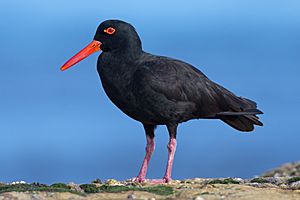Sooty oystercatcher facts for kids
Quick facts for kids Sooty oystercatcher |
|
|---|---|
 |
|
| Conservation status | |
| Scientific classification | |
| Genus: |
Haematopus
|
| Species: |
fuliginosus
|
The sooty oystercatcher (Haematopus fuliginosus) is a special type of oystercatcher. This wading bird lives only in Australia. You can often find it along Australia's coastline. It likes rocky shores best, but sometimes lives in river mouths called estuaries. All of its feathers are black. It has bright red eyes, a red ring around its eyes, and a red bill. Its legs are pink.
Contents
About the Sooty Oystercatcher
The famous bird expert John Gould first described the sooty oystercatcher in 1845. Its scientific name, fuliginosus, is a Latin word. It means "sooty," which describes its dark feathers.
There are two main types, or subspecies, of this bird. One lives along the southern coast of Australia. The other lives in northern Australia. The southern birds are usually bigger and heavier than the northern ones. The northern type has a more yellowish ring around its eye.
What Does a Sooty Oystercatcher Look Like?

Sooty oystercatchers are about 42 to 52 centimeters (16.5 to 20.5 inches) long. Their bill is about 5 to 8 centimeters (2 to 3 inches) long. They have all black feathers. Their legs are pink-red, and their bill and eyes are bright scarlet or orange-red.
These birds are the heaviest of all oystercatchers. They can weigh up to 980 grams (about 2.1 pounds). On average, they weigh around 819 grams (about 1.8 pounds). Female birds are usually larger and heavier than males. Males have shorter, thicker bills, while females have longer, thinner bills. This difference in bill length is very noticeable between male and female sooty oystercatchers.
Young sooty oystercatchers look a bit different. Their legs are grey-brown, and their bill has a brown tip. Their feathers look a bit browner, and their eyes are brown. By their second year, their bill, eyes, and legs turn red.
Where Sooty Oystercatchers Live
Sooty oystercatchers prefer rocky coastlines. They live only in Australia. Scientists believe there are about 11,500 of these birds in total. About 4,000 are the southern type, and 7,500 are the northern type.
You can find many of them around the coast of Tasmania and the Bass Strait islands. However, they are considered rare in South Australia and Queensland. They are listed as "Near Threatened" in Victoria and "Endangered" in New South Wales. This means their numbers are low in some areas.
What Sooty Oystercatchers Eat
Sooty oystercatchers usually look for food when the tide is low. They search for food in the area between the high and low tide marks. This is called the intertidal zone. They often feed for about two hours before and after low tide.
A study in 2011 showed that male and female birds eat different things. Only about 36% of their food choices were the same. Females often eat soft-bodied prey. This includes fish, crabs, bluebottle jellyfish, and worm-like creatures such as cunjevoi. Males prefer hard-shelled prey. They eat things like mussels (Mytilus planulatus), sea urchins, and turban shells (Lunella undulata and Lunella torquata). They also eat black periwinkles (Nerita atramentosa).
Sooty Oystercatcher Reproduction
Sooty oystercatchers lay two to three eggs at a time. They make their nests in rocky cracks or small hollows on the ground. Often, they choose an island or a high spot. This allows the parent birds to watch for danger.
Their eggs are oval-shaped and tapered. They are buff to beige in color. They have dark brown and lavender dots and splotches. Each egg is about 63 millimeters (2.5 inches) long and 42 millimeters (1.7 inches) wide.
See also
 In Spanish: Ostrero negro australiano para niños
In Spanish: Ostrero negro australiano para niños


